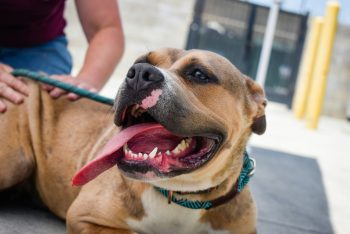Pit bulls, often a blanket term for several breeds including the American Pit Bull Terrier, American Staffordshire Terrier, and Staffordshire Bull Terrier, are as misunderstood as they are unique. Known for their strength, courage, and steadfast loyalty, pit bulls also exhibit a range of unusual habits that differentiate them from other dog breeds. These behaviors, while sometimes perplexing, are deeply rooted in the breed’s history, genetics, and former roles in society. Understanding these habits not only helps foster a safer and more harmonious relationship between pit bulls and their owners but also demystifies many myths surrounding the breed. In this article, we delve into seven of the most unusual habits of pit bulls, exploring the origins and implications of each. These insights aim to provide both current and prospective pit bull owners with a deeper appreciation of their canine companions.
1. Intense Staring
Pit bulls are known for their intense and prolonged staring, a habit that can be both unnerving and endearing. This behavior is deeply rooted in their history as dogs that were bred for baiting and later dog fighting, where maintaining focus on their opponent was crucial. Today, this intense stare often translates to a way they interact with their owners and other animals. It’s not necessarily a sign of aggression; rather, it’s a form of deep concentration and attention. Pit bulls tend to use their gaze to communicate their needs or desires, such as wanting to play or needing to go outside. This staring can sometimes be misunderstood by those unfamiliar with the breed, but it’s usually just a sign of their focus and intensity in their interactions.
2. Excessive Mouthing
Pit bulls often exhibit a habit called mouthing, where they gently chew or nibble on the hands and clothing of their humans. Unlike biting, mouthing is not aggressive but is rather a form of exploration and affection. This behavior is a remnant of their puppyhood, where pups use their mouths to explore the world around them. In pit bulls, this habit can persist well into adulthood. It’s important for owners to manage this behavior through training, especially since pit bulls have a strong jaw and can unintentionally cause harm. Encouraging the use of toys for chewing can help mitigate this habit and redirect their need to mouth towards a more appropriate outlet.
3. “Zoomies”
Pit bulls are infamous for their sudden bursts of energy, often referred to as “zoomies” or frantic random activity periods (FRAPs). During these episodes, a pit bull will run around in circles or back and forth in a seemingly uncontrollable manner. This display of energy is usually a way for them to release pent-up energy and can occur after bathing, during playtime, or when they get overly excited. While it may seem unusual, zoomies are a normal part of many dogs’ behavior, particularly youthful and energetic breeds like the pit bull. Owners can support their pit bull’s need for exercise by providing regular and structured playtimes.
4. Strong Prey Drive
The pit bull’s strong prey drive is another unusual habit, which can be traced back to their origins. Initially bred for bull-baiting and later as farm dogs for hunting and livestock management, pit bulls have a natural inclination to chase and capture fast-moving objects. This behavior makes them excellent at certain dog sports like lure coursing, but it can be a challenge in normal household settings, especially around smaller animals. Proper training and socialization from a young age are crucial to help manage their prey drive. Teaching commands such as “leave it” and providing plenty of mental stimulation can also be beneficial in curbing this instinct.
5. Exceptional Climbing Skills
Unlike many other dog breeds, pit bulls possess exceptional climbing skills. This can often lead to them overcoming fences and barriers that would typically contain other dogs. Their muscular build and powerful hind legs give them the ability to leap and climb, traits that were advantageous in their historical roles but can be problematic in a domestic setting. Owners need to ensure secure and high fencing in their yards and should not leave their pit bulls unattended outside. Training can also help manage this behavior, especially by reinforcing commands to stay within designated boundaries.
6. Snuggling and Bed-Hogging
For a breed that’s often portrayed as tough and rugged, pit bulls have a surprisingly tender habit of snuggling and bed-hogging. They love to stay close to their humans, often seeking comfort and warmth by curling up right next to them or even on top of them. This behavior reflects their affectionate and loyal nature. While it’s endearing, it can sometimes be a bit much, especially given their size. Owners might need to set boundaries and provide separate beds for their pets while still allowing time for cuddles and affection.
7. Water Obsession
Many pit bulls have a peculiar obsession with water, whether it’s puddles, pools, or sprinklers. They often can’t resist the urge to jump in and play whenever they see water. This habit can be traced back to their need for cooling off and the pleasure they get from playing in water, much like their ancestors might have done to stay cool while working outdoors. While this love for water is generally harmless, it’s important for owners to always supervise their pit bulls during water play to ensure their safety, especially in larger bodies of water or swimming pools.
The unusual habits of pit bulls, ranging from intense staring to an obsession with water, are key to understanding this unique breed. Each behavior has its roots in the breed’s history and genetics, and recognizing these can help foster better relationships between pit bulls and their owners. By understanding and managing these habits through proper training and care, owners can ensure that their pit bulls are not only well-behaved but also happy and healthy companions.
The post The 7 Most Unusual Habits of Pit Bulls appeared first on iHeartDogs.com.

